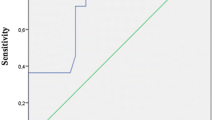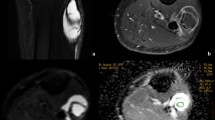Abstract
Objective
Equivalent cross-relaxation rate (ECR) imaging (ECRI), which allows quantitation of macromolecular tissue components, is a potentially useful nuclear magnetic resonance (NMR) technique for histopathological diagnosis. The purpose of this study was to compare ECR values among various histological types and assess the correlation between ECR and tumor cellular image in soft tissue tumors.
Materials and methods
We performed ECRI to evaluate cellular images of soft tissue tumors and tumorous lesions. Thirty-three patients who underwent evaluation with MRI and ECRI at the first visit were enrolled. Resection or biopsy was performed to obtain a histopathological diagnosis, followed by cell density measurement. ECR values of the histological subgroups were compared, and the correlation between ECR and cell density was analyzed to assess whether ECR can be used as an indicator of histological cell density.
Results
ECR values for benign tumors varied widely and were not significantly different from those for malignant tumors. However, the mean ECR value was significantly higher for high-grade malignant tumors than for low-grade tumors (p < 0.01). Moreover, a positive correlation was found between ECR and cell density (r s = 0.72; p < 0.01).
Conclusions
ECR reflects the cell density and malignancy grade of a soft tissue tumor. ECRI could provide cellular imaging and useful clinical information to aid the pre-operative diagnosis of soft tissue tumors.






Similar content being viewed by others
References
van Rijswijk CSP, Geirnaerdt MJA, Hogendoorn PCW, et al. Soft-tissue tumors: value of static and dynamic gadopentetate dimeglumine-enhanced MR imaging in prediction of malignancy. Radiology. 2004;233:493–502.
Fayad LM, Jacobs MA, Wang X, et al. Musculoskeletal tumors: how to use anatomic, functional, and metabolic MR techniques. Radiology. 2012;265:340–56.
Namimoto T, Yamashita Y, Awai K, et al. Combined use of T2-weighted and diffusion-weighted 3-T MR imaging for differentiating uterine sarcomas from benign leiomyomas. Eur Radiol. 2009;19:2756–64.
Reichardt W, Juettner E, Uhl M, et al. Diffusion-weighted imaging as predictor of therapy response in an animal model of Ewing sarcoma. Invest Radiol. 2009;44:298–303.
Koenig SH, Bryant RG, Hallenga K, et al. Magnetic cross-relaxation among protons in protein solutions. Biochemistry. 1978;17:4348–58.
Ulmer JL, Mathews VP, Hamilton CA, et al. Magnetization transfer or spin-lock? An investigation of off-resonance saturation pulse imaging with varying frequency offsets. AJNR Am J Neuroradiol. 1996;17:805–19.
Pui MH, Wang Y. Diffusion and magnetization transfer MRI of brain infarct, infection, and tumor in children. Clin Imaging. 2005;29:162–71.
Kurki T, Lundbom N, Valtonen S. Tissue characterisation of intracranial tumours: the value of magnetisation transfer and conventional MRI. Neuroradiology. 1995;37:515–21.
Bonini RHM, Zeotti D, Saraiva LAL, et al. Magnetization transfer ratio as a predictor of malignancy in breast lesions: preliminary results. Magn Reson Med. 2008;59:1030–4.
Heller SL, Moy L, Lavianlivi S, et al. Differentiation of malignant and benign breast lesions using magnetization transfer imaging and dynamic contrast-enhanced MRI. J Magn Reson Imaging. 2013;37:138–45.
Tsukushi S, Takahashi M, Miyagi N, et al. Magnetization transfer ratios of musculoskeletal tumors. J Orthop Sci. 2002;7:524–7.
Sogami M, Era S, Kinosada Y, et al. Basic studies on the equivalent cross-relaxation rate imaging (equivalent CRI)–phantom studies. NMR Biomed. 2001;14:367–75.
Matsushima S, Takasu A, Inai Y, et al. Equivalent cross-relaxation rate imaging in the synthetic copolymer gels and invasive ductal carcinomas of the breast. Magn Reson Imaging. 2002;20:285–93.
Mastsushima S, Nishiofuku H, Iwata H, et al. Equivalent cross-relaxation rate imaging of axillary lymph nodes in breast cancer. J Magn Reson Imaging. 2008;27:1278–83.
Nishiofuku H, Matsushima S, Taguchi O, et al. Cellular imaging using equivalent cross-relaxation rate technique in rabbit VX-2 tumor model. Cancer Inform. 2011;10:227–32.
Enneking WF, Spanier SS, Goodman MA. A system for the surgical staging of musculoskeletal sarcoma. Clin Orthop Relat Res. 1980;153:106–20.
Zaremba L. FDA guidance for MR system safety and patient exposures: current status and future considerations. In: Shellock FG, ed: Magnetic resonance procedures: health effects and safety. Boca Raton: CRC Press. 2001;183–196.
Schnapauff D, Zeile M, Niederhagen MB, et al. Diffusion-weighted echo-planar magnetic resonance imaging for the assessment of tumor cellularity in patients with soft-tissue sarcomas. J Magn Reson Imaging. 2009;29:1355–9.
Virta A, Kormano M, Paranko J. Magnetization transfer of pure DNA and purified sperm nuclei. MAGMA. 1996;4:135–8.
Bailey C, Desmond KL, Czarnota GJ, et al. Quantitative magnetization transfer studies of apoptotic cell death. Magn Reson Med. 2011;66:264–9.
Takashima S, Wang J, Takayama F, et al. Parotid masses: prediction of malignancy using magnetization transfer and MR imaging findings. Am J Roentgenol. 2001;176:1577–84.
Matsushima S, Sasaki F, Sarumaru S, et al. Equivalent cross relaxation rate image for decreasing a false negative case of sentinel lymph node biopsy. Magn Reson Imaging. 2003;21:1045–7.
Matsushima S, Sasaki F, Yamaura H, et al. Equivalent cross-relaxation rate imaging for sentinel lymph node biopsy in breast carcinoma. Magn Reson Med. 2005;54:1300–4.
Mendenhall WM, Mendenhall CM, Reith JD, et al. Pigmented villonodular synovitis. Am J Clin Oncol. 2006;29:548–50.
Dyke JP, Panicek DM, Healey JH, et al. Osteogenic and Ewing sarcomas: estimation of necrotic fraction during induction chemotherapy with dynamic contrast-enhanced MR imaging. Radiology. 2003;228:271–8.
Gaston LL, Di Bella C, Slavin J, et al. 18F-FDG PET response to neoadjuvant chemotherapy for Ewing sarcoma and osteosarcoma are different. Skeletal Radiol. 2011;40:1007–15.
Conflict of interest
None of the authors has declared any conflicts of interest.
Author information
Authors and Affiliations
Corresponding author
Rights and permissions
About this article
Cite this article
Hamada, S., Matsushima, S., Sugiura, H. et al. Correlation between equivalent cross-relaxation rate and cellular density in soft tissue tumors. Skeletal Radiol 43, 141–147 (2014). https://doi.org/10.1007/s00256-013-1754-9
Received:
Revised:
Accepted:
Published:
Issue Date:
DOI: https://doi.org/10.1007/s00256-013-1754-9




